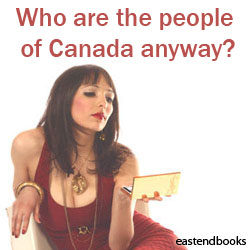Happy birthday to who? .. where does the Six Nations Caledonia protest go from here?
Feb 28th, 2007 | By Randall White | Category: Canadian Provinces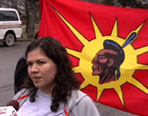 What the press is now calling “Canada’s longest running aboriginal standoff,” in Caledonia, Ontario, began on February 28, 2006. It is one year old today. And by all the latest accounts it will be two years old this time next year, and three years old the year after that. According to spokesperson Janie Jamieson: “Six Nations protesters made it through a cold winter last year and will remain on the land through several more if they have to.” Meanwhile, the non-natives in Caledonia are getting restless. And this could certainly be a key local issue in the first fixed-date Ontario provincial election on October 10 this year. Right now it seems doubtful that it will become much more than that, even in Ontario to say nothing of Canada at large. But at least some among us are still wondering: what’s really going on?
What the press is now calling “Canada’s longest running aboriginal standoff,” in Caledonia, Ontario, began on February 28, 2006. It is one year old today. And by all the latest accounts it will be two years old this time next year, and three years old the year after that. According to spokesperson Janie Jamieson: “Six Nations protesters made it through a cold winter last year and will remain on the land through several more if they have to.” Meanwhile, the non-natives in Caledonia are getting restless. And this could certainly be a key local issue in the first fixed-date Ontario provincial election on October 10 this year. Right now it seems doubtful that it will become much more than that, even in Ontario to say nothing of Canada at large. But at least some among us are still wondering: what’s really going on?
1. The good news from Caledonia?
 The current becalming (or half-becalming) of the Six Nations Caledonia protest may partly reflect just how much even the election of a Stephen Harper Conservative minority government in Ottawa has shifted the Canada-wide political mood in the past year too. But it also raises more uneasy questions about aboriginal policy and the present non-aboriginal majority of the Canadian people, that none of us on any side of the issue seems quite ready to confront just yet.
The current becalming (or half-becalming) of the Six Nations Caledonia protest may partly reflect just how much even the election of a Stephen Harper Conservative minority government in Ottawa has shifted the Canada-wide political mood in the past year too. But it also raises more uneasy questions about aboriginal policy and the present non-aboriginal majority of the Canadian people, that none of us on any side of the issue seems quite ready to confront just yet.
To start with, many participants, observers, and just interested voters will rightly enough want to focus attention on the part of the glass that is still half-full. According to federal Indian Affairs Minister Jim Prentice, e.g.: “The occupation that began when a small group of aboriginals blocked construction on the housing development in Caledonia, Ont., a short drive south of Hamilton, could have been far worse’ … Negotiations have brought relative stability and calm to the small town, he said. Compared to the armed standoff between Mohawks and the Canadian army in Oka, Que. that killed a police officer 17 years ago, Prentice said Caledonia has been handled in a very responsible way.'”
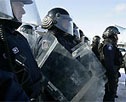 Insofar as this is true enough, it is certainly far more to the credit of Dalton McGuinty’s Liberal provincial regime at Queen’s Park, than it is to “Canada’s new government” in Ottawa. And, good Canadian Conservative that he is, Indian Affairs Minister Prentice apparently did not also mention to reporters that the current Caledonia standoff is a lot better than the comparable situation at Ipperwash Park on beautiful Lake Huron only 12 years ago, during the early days of Mike Harris’s law-and-order Ontario Tories – when the Ontario Provincial Police, inadvertently or otherwise, tragically shot the aboriginal person of Canada Dudley George dead.
Insofar as this is true enough, it is certainly far more to the credit of Dalton McGuinty’s Liberal provincial regime at Queen’s Park, than it is to “Canada’s new government” in Ottawa. And, good Canadian Conservative that he is, Indian Affairs Minister Prentice apparently did not also mention to reporters that the current Caledonia standoff is a lot better than the comparable situation at Ipperwash Park on beautiful Lake Huron only 12 years ago, during the early days of Mike Harris’s law-and-order Ontario Tories – when the Ontario Provincial Police, inadvertently or otherwise, tragically shot the aboriginal person of Canada Dudley George dead.
The current leader of the Ontario Tories, who bears the happy name of John Tory, is said to be not at all like Mike Harris. Mr. Tory is more in the mold of the old Red Tory gentlemen who made Bill Davis’s Ontario Progressive Conservatives such a tolerable centre-right provincial government for Canada’s most populous province, back in the 1970s and early 1980s. But that apparently does not mean that Mr. Tory’s Tories are altogether unwilling to play some more polite version of Mike Harris’s right-wing law and order adventures with the Caledonia issue (if that’s where enough of the people who vote do want to go).
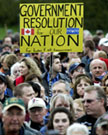 So it has been reported that: “The Liberals should be ashamed of themselves, said Conservative Leader John Tory. Despite the fact aboriginal land claims are Ottawa’s responsibility, McGuinty could have ended the occupation by showing some leadership … There’s a tool (McGuinty) has in his toolbox – it’s called being the premier of Ontario and acting like a premier,’ Tory said. He should say to these people that it doesn’t matter who you are, it doesn’t matter what your claim is. We have certain ways of resolving disputes in our society.'”
So it has been reported that: “The Liberals should be ashamed of themselves, said Conservative Leader John Tory. Despite the fact aboriginal land claims are Ottawa’s responsibility, McGuinty could have ended the occupation by showing some leadership … There’s a tool (McGuinty) has in his toolbox – it’s called being the premier of Ontario and acting like a premier,’ Tory said. He should say to these people that it doesn’t matter who you are, it doesn’t matter what your claim is. We have certain ways of resolving disputes in our society.'”
Except just what does this mean in the real world? On its first birthday, there does seem some degree of wider public support for ending the Six Nations occupation at Caledonia by force. (See Appendix below, e.g.) But once you start to think about it seriously, the great question remains: how do you know that, if you do start this kind of thing, you won’t wind up with someone tragically shot dead, just like at Ipperwash all over again? Janie Jamieson says the “Six Nations protesters” are ready to keep at the negotiations for another few years. And even federal Indian Affairs Minister Prentice is saying that Caledonia “is a complicated matter. I’ve always known that it would be a challenging situation that would go on for some time … If people are patient, we will get this resolved.”
2. The secret mission of the Ontario Ministry of Municipal Affairs
 Dalton McGuinty’s Ontario provincial government “continues to insist the power to end the dispute rests with Ottawa. Although Ontario [now] owns the occupied land, David Ramsay, the [provincial] minister responsible for aboriginal affairs, said the Liberals have exhausted all the tools we have’ to end the dispute. We cannot resolve outstanding land claims,’ Ramsay said. That’s up to the federal government.'”
Dalton McGuinty’s Ontario provincial government “continues to insist the power to end the dispute rests with Ottawa. Although Ontario [now] owns the occupied land, David Ramsay, the [provincial] minister responsible for aboriginal affairs, said the Liberals have exhausted all the tools we have’ to end the dispute. We cannot resolve outstanding land claims,’ Ramsay said. That’s up to the federal government.'”
As true as this in many ways actually is, it has been the McGuinty government at Queen’s Park that has so far had to deal with the brunt of the “Property and Civil Rights in the Province” side of the issue. [See section 92 (13) of the Constitution Act 1867.] It was, e.g., the Ontario provincial government that bought out the developer who was trying to put new houses on the disputed land that the Six Nations are now occupying – and thus turned off this critical tap of strict legal pressure to go gung ho on enforcing law and order in some precipitous and dangerous way, that would not leave enough time for patient negotiations to end things peacefully.
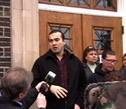 Premier McGuinty himself of course understands that his party’s current government is almost certainly going to be having some trouble in the local area when the October 10 provincial election rolls around. The great complaint of many among the non-aboriginal majority in Caledonia itself is that if the Six Nations protest is going to drag on for several more years, it is almost certainly going to terminally destroy their homes and livelihoods. And if you have even a vague up-close sense of small towns on the great hinge between the Northeast and the more northerly North American Midwest, on the one hand, and, on the other, the contemporary folkways of the once great and still proud Six Nations Iroquois of Northern New York and Southern Ontario, you can easily imagine that this complaint is serious enough.
Premier McGuinty himself of course understands that his party’s current government is almost certainly going to be having some trouble in the local area when the October 10 provincial election rolls around. The great complaint of many among the non-aboriginal majority in Caledonia itself is that if the Six Nations protest is going to drag on for several more years, it is almost certainly going to terminally destroy their homes and livelihoods. And if you have even a vague up-close sense of small towns on the great hinge between the Northeast and the more northerly North American Midwest, on the one hand, and, on the other, the contemporary folkways of the once great and still proud Six Nations Iroquois of Northern New York and Southern Ontario, you can easily imagine that this complaint is serious enough.
According to Marie Trainer, mayor of Haldimand County (in which Caledonia is located) “despair” is setting in among many non-aboriginal residents of the small town: “The site is a mess,’ she said. Six Nations flags fly everywhere around the site, which includes a makeshift camp on the disputed land and non-stop police patrols – all a constant reminder for locals of the persistent, bitter conflict … You’re in the middle of a lovely town and you’ve got this unsightly thing in the middle of it,’ Trainer said. It doesn’t help anything. The occupiers need to leave and the flags need to come down.'”
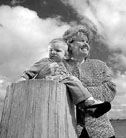 Assuming that both the Conservatives at Ottawa and the Liberals at Queen’s Park (if not quite Mr. Tory’s Conservatives at Queen’s Park?) have somehow managed to agree that nothing quite like a forceful ending of the aboriginal occupation will in fact be happening any time soon, what is going to be done on this front? According to a report from back on February 2: “The Ontario government is holding closed door meetings with an unknown number of residents to get advice on compensation for homeowners affected by the Caledonia standoff … The Liberal government is asking the group, called the Caledonia Community Committee, to sign agreements to keep the discussions confidential.”
Assuming that both the Conservatives at Ottawa and the Liberals at Queen’s Park (if not quite Mr. Tory’s Conservatives at Queen’s Park?) have somehow managed to agree that nothing quite like a forceful ending of the aboriginal occupation will in fact be happening any time soon, what is going to be done on this front? According to a report from back on February 2: “The Ontario government is holding closed door meetings with an unknown number of residents to get advice on compensation for homeowners affected by the Caledonia standoff … The Liberal government is asking the group, called the Caledonia Community Committee, to sign agreements to keep the discussions confidential.”
There were understandable local complaints about the “confidentiality” here. And as often happens in such cases, it was provincial bureaucrats and not elected politicians in the immediate line of fire. In particular it was Roger Moyer, local government manager in the London regional office of the Ontario Ministry of Municipal Affairs. According to the Hamilton Spectator, he wouldn’t “say how many residents make up the Caledonia committee or when and where they meet … He would only say the group is meeting at a Caledonia location on a weekly basis. He said it’s only meeting for a few weeks and is expected to file its advice to Municipal Affairs Minister John Gerretsen within a couple of weeks … They are holding these meetings in confidence … They are volunteers. They’ve got jobs, families … I’m not calling these secret meetings. The minister asked a group of volunteers to meet to give him advice.'”
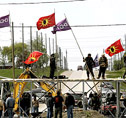 The most radical political demand among non-aboriginal Caledonians is for a provincial government buyout of the most direly affected members of the community. I.e., some residents want Queen’s Park to do for them what it has already done for the owner of the disputed land on the former Douglas Creek Estates housing development, that the Six Nations protesters are now occupying. Give them enough money to pick up the pieces of their lives and business and move somewhere else – far away from the Six Nations Iroquois reserve in the Grand River valley.
The most radical political demand among non-aboriginal Caledonians is for a provincial government buyout of the most direly affected members of the community. I.e., some residents want Queen’s Park to do for them what it has already done for the owner of the disputed land on the former Douglas Creek Estates housing development, that the Six Nations protesters are now occupying. Give them enough money to pick up the pieces of their lives and business and move somewhere else – far away from the Six Nations Iroquois reserve in the Grand River valley.
According to Roger Moyer, this is not very likely: “Moyer said that whatever compensation package is decided on by the government will be made public. Some residents last year wanted the government to buy them out. Moyer said Queen’s Park is aware of the requests, but added, Certainly, at this point, the government is not contemplating the buyout of properties.'” (The Hamilton Spectator report then concluded by noting that Mr. Moyer’s community “meetings stem from an announcement last June that the province would consider an assistance program for residents adversely affected by the occupation of Douglas Creek Estates.” You might guess that whatever the program finally involves will be ready well before the October 10 Ontario election.)
3. Still crazy in Ottawa after all these years?
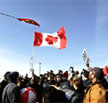 Whatever else, it does remain true that, as Dalton McGuinty’s Ontario provincial government continues to insist, “the power to end the dispute rests with Ottawa.” Queen’s Park in Toronto cannot resolve outstanding aboriginal land claims. That is “up to the federal government.” And what, you might well ask, has Stephen Harper’s new federal government been doing over the past year? And what should it be doing now?
Whatever else, it does remain true that, as Dalton McGuinty’s Ontario provincial government continues to insist, “the power to end the dispute rests with Ottawa.” Queen’s Park in Toronto cannot resolve outstanding aboriginal land claims. That is “up to the federal government.” And what, you might well ask, has Stephen Harper’s new federal government been doing over the past year? And what should it be doing now?
Well, Government of Canada representatives, along with those of the Province of Ontario, have been meeting, for many long hours apparently, with representatives of the Six Nations Iroquois, ostensibly to discuss the resolution of the land claim dispute regarding what was until recently the Douglas Creek Estates subdivision.
Then, about a month ago now, on January 27, 2007, it was reported that: “Ottawa has told the Six Nations Confederacy that its claim to a former housing development in the Southwestern Ontario town of Caledonia would not be recognized in court … The federal government sets out that position in a Department of Justice report presented … to Six Nations Confederacy officials who are negotiating with federal and provincial officials to try to end the 11-month occupation …
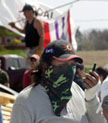 “Federal negotiator Barbara McDougall said although the government says Six Nations does not have a legitimate claim to that particular property,’ it doesn’t mean there are no solutions … Confederacy spokeswoman Hazel Hill said Six Nations negotiators do not believe the Justice Department report reflects the true story. But she said although both sides are frustrated by the slow pace of talks, she remains confident the situation can be resolved.”
“Federal negotiator Barbara McDougall said although the government says Six Nations does not have a legitimate claim to that particular property,’ it doesn’t mean there are no solutions … Confederacy spokeswoman Hazel Hill said Six Nations negotiators do not believe the Justice Department report reflects the true story. But she said although both sides are frustrated by the slow pace of talks, she remains confident the situation can be resolved.”
More recently, on February 25, 2007, it was reported that, according to federal Indian Affairs Minister Jim Prentice: “Negotiators working to resolve the 200-year-old land claim and end the year-long occupation are still working on peripheral parts of the land claim, and have a long way to go before they can bring an end to the standoff … They are dealing with intractable’ and challenging’ issues stemming from one of the oldest land claims in Canada, Prentice said.”
In one key sense, you might say, all this is somewhat beside the point. Because the fundamental issue that has prompted the Six Nations occupation of the Douglas Creek site in Caledonia, Ontario is not really just a complex legal argument over a 200-year-old land claim. It is the increasingly troubled circumstances of at least substantial numbers among what sections 25 and 35 of the Canadian Constitution Act 1982 call “the aboriginal peoples of Canada” (who are, by the way, one of the most rapidly growing demographic groups in the country’s population today).
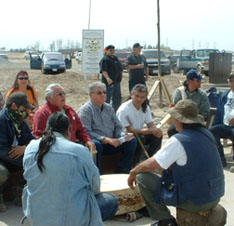 So what should Ottawa really be trying to do, apart from just continuing to discuss the intractable and challenging issues stemming from one of the oldest land claims in Canada with representatives of the Six Nations Confederacy – for the next several years?
So what should Ottawa really be trying to do, apart from just continuing to discuss the intractable and challenging issues stemming from one of the oldest land claims in Canada with representatives of the Six Nations Confederacy – for the next several years?
A year ago one quite practical answer seemed obvious enough. The new Harper government should not be turning its back on the Kelowna Accord on Canadian aboriginal policy reform, finally negotiated late in November 2005 by the federal and provincial governments and national aboriginal leaders. Whatever else, again, this was a worthwhile step ahead on the bigger problem – that could help reduce the growing deep frustration that is energizing such things as the Six Nations protest at Caledonia.
As it has happened, the Harper Conservative minority government in Ottawa has effectively turned its back on the Kelowna Accord (even if Jim Prentice has shown that he is not an entirely unreasonable and neanderthal federal Indian Affairs Minister). And, ironically enough, Mr. Harper and Mr. Prentice may have even got away with this obvious mistake so far, partly because the rougher edges of the Six Nations land claim protest at Caledonia (and various echoes over the past year in other parts of the country) have somewhat reduced support for aboriginal policy reform among the non-aboriginal majority of the Canadian people.
 Yet it may also be that the Kelowna Accord will finally prove vaguely akin to the Kyoto Accord in the Harper government’s ultimate legacy – whenever and however Canada’s new government of the moment may also come to its natural end, in the fullness of who knows just how much time. Stephen Harper, that is, may continue to turn his back on both “accords” that start with the letter “K,” while increasingly finding that he has to live up to more and more of their ultimate practical policy thrust, if he wants to continue on as the new Prime Minister of Canada (a job he is apparently finding he likes quite a lot).
Yet it may also be that the Kelowna Accord will finally prove vaguely akin to the Kyoto Accord in the Harper government’s ultimate legacy – whenever and however Canada’s new government of the moment may also come to its natural end, in the fullness of who knows just how much time. Stephen Harper, that is, may continue to turn his back on both “accords” that start with the letter “K,” while increasingly finding that he has to live up to more and more of their ultimate practical policy thrust, if he wants to continue on as the new Prime Minister of Canada (a job he is apparently finding he likes quite a lot).
4. A footnote on Terrence Malick’s new movie, The New World … and Canada’s new Constitution Act 1982
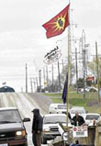 For better or worse, the Caledonia protest is not an isolated incident. There are, e.g., such allied phenomena as the sympathy protest on the Lion’s Gate Bridge in Vancouver last year, the Kashechewan water quality crisis on James Bay, aboriginal protests over diamond mining in Northern Ontario, and the new uncertainty that a vast assortment of aboriginal land claims has brought to future resource development in British Columbia. What all this makes clear enough is that there are some quite real and growing problems with aboriginal policy in Canada today. And ultimately these problems are not going to go away.
For better or worse, the Caledonia protest is not an isolated incident. There are, e.g., such allied phenomena as the sympathy protest on the Lion’s Gate Bridge in Vancouver last year, the Kashechewan water quality crisis on James Bay, aboriginal protests over diamond mining in Northern Ontario, and the new uncertainty that a vast assortment of aboriginal land claims has brought to future resource development in British Columbia. What all this makes clear enough is that there are some quite real and growing problems with aboriginal policy in Canada today. And ultimately these problems are not going to go away.
Aboriginal policy reform is a bigger issue in Canada at the moment than it is in the global colossus of the United States next door. This is partly because aboriginal peoples are relatively more prominent in Canada. (On rough back-of-the-envelope calculations, there are only about twice as many “native North Americans” in the United States as there are in Canada, compared with almost 10 times as many people at large. Which, you could almost say, makes “aboriginal peoples,” as the Canadian officialese has it these days, five times more important in Canada than in the USA.) Aboriginal policy is also more important in Canada partly because of its unique constitutional development since the late 1960s. (Including the Quebec sovereigntist movement and the injection of aboriginal rights into the Constitution Act 1982 – and the much longer, as Mr. Harper might put it, “unique and eclectic” Canadian history on which all this draws.)
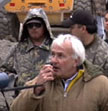 Yet Canada increasingly remains very much a part of the wider North American continent – and is of course very much influenced by all manner of developments in the USA today. And it is interesting that The New World, writer-director Terrence Malick’s fresh movie-look at the legend of the Powhatan “princess” Pocahontas, in early 17th century Virginia, was shown at a few New York and Los Angeles theaters in December 2005, “to qualify for the Academy Awards” that year. But “the film’s wide release” only “began on January 20, 2006” – just over a month before the Six Nations protest in Caledonia, Ontario began.
Yet Canada increasingly remains very much a part of the wider North American continent – and is of course very much influenced by all manner of developments in the USA today. And it is interesting that The New World, writer-director Terrence Malick’s fresh movie-look at the legend of the Powhatan “princess” Pocahontas, in early 17th century Virginia, was shown at a few New York and Los Angeles theaters in December 2005, “to qualify for the Academy Awards” that year. But “the film’s wide release” only “began on January 20, 2006” – just over a month before the Six Nations protest in Caledonia, Ontario began.
In the United States, as in Canada again, the past half century has seen a virtual revolution in historical understandings of the early relationships between “Indians and Europeans” in North America. Mr. Malick has at least somewhat connected with this revolution in his interesting new movie. Whatever else, The New World enlarges our sense of what it was like when North American Indians first met Europeans 400 years ago. It also retails what the critic Karina Longworth has called “the best puppy-love soap opera I’ve ever seen.” It may say something about the widest political mood in the United States and Canada today that, in spite of such both high and low virtues, Mr. Malick’s movie does not seem to have won great popular attention.
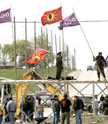 Some current historians of the era will find that writer-director Malick’s portrayal of the early 17th century Powhatan Confederacy is still somewhat too ideologically Eurocentric. Aboriginal peoples in The New World still come off as more childlike and less skilled and cunningly impressive than they do, e.g., in the contemporary writings of the French priests and aristocratic adventurers, whose travel accounts and outpost reports so enrich modern Canada’s earliest history. But Malick’s depiction of the initial political (and economic) balance of the Indian-European encounter does seem somehow more true to what really happened than usual. And no one watching his movie could imagine that it was all just a matter of Europeans coming to the new world and finding almost no one else there, and deciding to colonize it in the larger public interest of the global village.
Some current historians of the era will find that writer-director Malick’s portrayal of the early 17th century Powhatan Confederacy is still somewhat too ideologically Eurocentric. Aboriginal peoples in The New World still come off as more childlike and less skilled and cunningly impressive than they do, e.g., in the contemporary writings of the French priests and aristocratic adventurers, whose travel accounts and outpost reports so enrich modern Canada’s earliest history. But Malick’s depiction of the initial political (and economic) balance of the Indian-European encounter does seem somehow more true to what really happened than usual. And no one watching his movie could imagine that it was all just a matter of Europeans coming to the new world and finding almost no one else there, and deciding to colonize it in the larger public interest of the global village.
Again, the Indian-European “middle ground” of the 17th (and 18th and even, in Canada, early 19th centuries) was also more important in Canada than in the United States. As the near-great Canadian economic historian Harold Innis urged in his classic book of 1930 on the quite remarkable growth of the transcontinental Indian-European Fur Trade in Canada (“the forerunner of the present confederation,” in Innis’s memorable words): “We have not yet realized that the Indian and his culture were fundamental to the growth of Canadian institutions.” Ancestors of the Six Nations Iroquois at Caledonia today were, local historians have now begun to appreciate, the earliest founders of the present Toronto metropolis. (And all of Toronto, Ontario, and Canada are aboriginal words.) In the most recent past such Canadian legal scholars as Brian Slattery, at the Osgoode Hall Law School in Toronto, and Jeremy Webber, at the University of Victoria Faculty of Law in British Columbia, have written about “the period in eastern North America and the Great Lakes region when power was, for a time, evenly balanced” between Indians and Europeans, on “a constitutional middle ground” that still has echoes in Canadian law.
 At some point soon enough in the long evolution of the Six Nations protest at Caledonia in southwestern Ontario today, someone should probably point out to someone what it actually does already say in sections 25 and 35 of Canada’s new Constitution Act 1982: “The guarantee in this Charter [of Canadian Rights and Freedoms] … shall not be construed so as to abrogate or derogate from any aboriginal, treaty or other rights or freedoms that pertain to the aboriginal peoples of Canada” (section 25) ; and “The existing aboriginal and treaty rights of the aboriginal peoples of Canada are hereby recognized and affirmed” (section 35).
At some point soon enough in the long evolution of the Six Nations protest at Caledonia in southwestern Ontario today, someone should probably point out to someone what it actually does already say in sections 25 and 35 of Canada’s new Constitution Act 1982: “The guarantee in this Charter [of Canadian Rights and Freedoms] … shall not be construed so as to abrogate or derogate from any aboriginal, treaty or other rights or freedoms that pertain to the aboriginal peoples of Canada” (section 25) ; and “The existing aboriginal and treaty rights of the aboriginal peoples of Canada are hereby recognized and affirmed” (section 35).
Of course, just what this means practically in the real world of the early 21st century remains very much up in the air. And that is probably the deepest reason why the Six Nations protest at Caledonia has gone on so long now, and promises to go on longer still. As yet, no non-aboriginal or aboriginal negotiators (and/or their principals at Queen’s Park and Ottawa and in the Grand River valley) are ready to seriously dig into the very big question of just what Harold Innis meant when he said, more than 75 years ago, that “the Indian and his culture were fundamental to the growth of Canadian institutions.” Maybe if the Caledonia protest does drag on for another few years, all this will finally start to change – in some kind of constructive and forward-looking way. That, at least, would seem to be the most optimal ultimate result.
Randall White is the author of a number of books, including Ontario 1610-1985: A Political and Economic History, and Ontario Since 1985.
APPENDIX: COUNTERWEIGHTS EDITORS ON THE GLOBE AND MAIL’S CALEDONIA ONLINE POLL, FEBRUARY 26, 2007
Online opinion polls are yet another marvel of the Age of the Internet. But of course you always have to take them with various grains of salt. Apart from all the factors that can make the respondents depart dramatically from any such thing as a statistically random sample, online polls can also be easy prey for rabid networks of Internet political junkies (and some of their friendly robots), who want public opinion to look more like they’d like it to look than it really is.
On February 26 the online poll regularly featured in the Net edition of Canada’s self-confessed national newspaper, the Globe and Mail, asked the interesting question: “What approach would you use to end the long-standing Caledonia protest?” Past inquiries indicate that the Globe and Mail itself is too busy to keep any records of how the answers to such questions may change over the day on which they’re asked. But counterweights does sometimes keep somewhat casual records of this sort. And on February 26, at 12:40 PM only 35% of 7600 respondents were answering the question of the day with “Use force to bring the protest to an end.” By the end of the day 74% of almost 42,000 [alleged human?] respondents had given the same answer. What does it all mean? At least some people who read the online Globe and Mail really would like to see the ongoing Six Nations occupation in Caledonia brought to an end by the armed force of the law. But the real number (even of Globe and Mail online readers, to say nothing of the Canadian people, coast to coast to coast) is almost certainly nothing like 74%.
“What approach would you use to end the long-standing Caledonia protest?” | ||
12:40 PM Feb 26, 2007 | End of day Feb 26, 2007 | |
Keep negotiations going until agreement is reached | (32%) 2464 votes | (17%) 6947 votes |
Set a deadline for negotiations to bear fruit | (16%) 1236 votes | (4%) 1831 votes |
Buy out the homeowners and help them move | (17%) 1254 votes | (6%) 2310 votes |
Use force to bring the protest to an end | (35%) 2646 votes | (74%) 30875 votes |
TOTAL VOTES | 7,600 | 41,963 |
